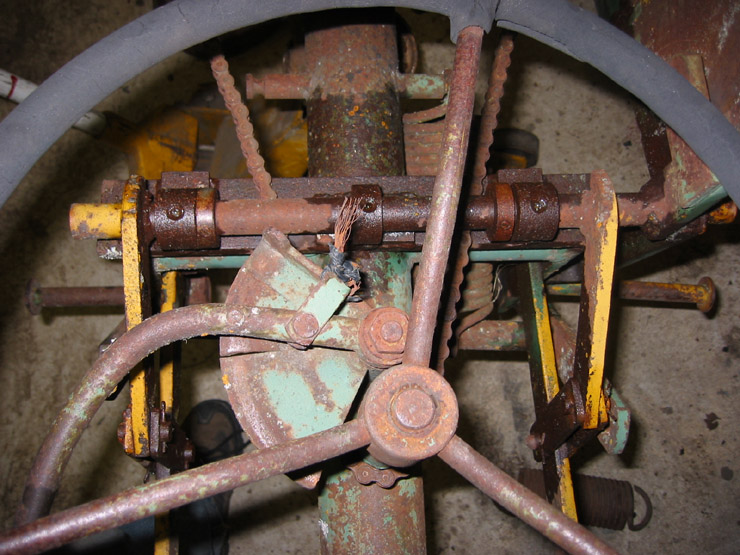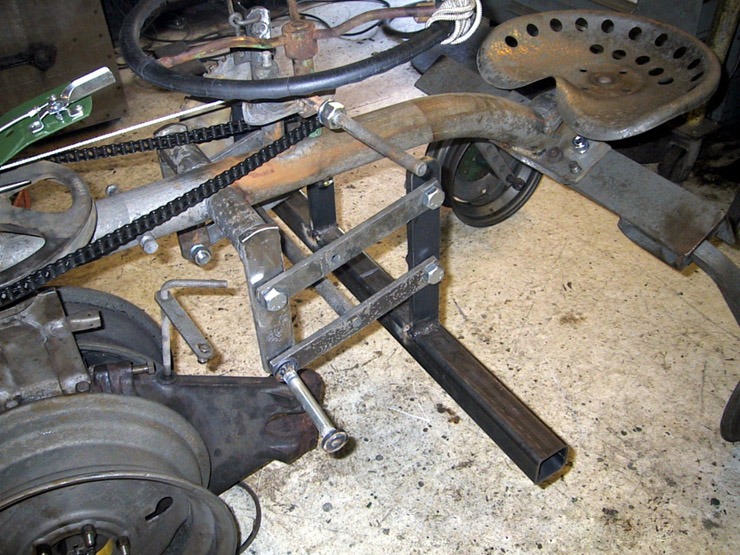 |
 |
 |
 |
 |
|
|
|
Bolens Ridemaster Blog
| |||||||||||||||||||||||||||||||||
On this page you will see the restoration of a 1954 Bolens Ridemaster Model 35AB301 garden tractor |
|
| May 2004
This Ridemaster was found as a lawn ornament somewhere in Tsawwassen BC by my friend Ed Deak sometime in 1978. Ed hauled it up to his ranch near Williams Lake BC and deposited it behind his woodworking shop. With all the things one has to deal with on a ranch, Ed never got around to doing anything with it, so he gave it to me, knowing that if anyone could bring it back to life, I could. This project was done in Ed's honour. Here it is being dug out of the grave it had been resting peacefully in for the last quarter century. It was dissembled when it was dropped here, but we managed to locate the majority of parts. Judging from the condition of the engine, it died because of a rod bearing failure. |
 |
| One needs a healthy imagination to get into basket case projects like this. Not only is this a weird beast, it's not very well documented so I had no idea how the thing should go together and what pieces belonged to it and what might be missing. Fortunately, Ed's memory is superb so we only missed loading the wheel spacers. |  |
| The condition could only be described as, um, "barn fresh". Fortunately tractors are made of good heavy steel, so even with 50 years of outdoor exposure the damage was not that bad. I've never restored anything covered in lichen before! |  |
| During the initial assessment it was obvious that sometime in the past the tool bar elevator mechanism had been modified in some bizarre way. Not having a manual or any reference photos I couldn't tell what this was supposed to look like, but the gobby welds were a tip-off that something was wrong. |  |
| The steering wheel had faired worst from exposure. Rust had taken hold in the steel armature and the plastic was cracking and falling off. The elevator mechanism can be seen below the wheel. The bent arm on the left of the wheel is the 'clutch', which is supposed to be straight. |  |
| Because of the poor documentation of these machines, colour matching had to be done from the best remaining paint samples. The wheel colours came from inside the rear rims where they were bolted onto the hub and protected by grease. The main colour came from underneath the serial number plate. |  |
| After I had assessed the machine,
inventoried everything, did some background research and made reference
photos, it came apart. A few fasteners needed the help of a torch, and a
few had to be cut off. The next step, as with all my restorations, is a
weekend in the caustic soda "spa" then the derusting bath. There
is nothing like working with bare gray steel.
The gearcase was cleaned as well so everything was stripped out of it, inspected and put back in. The only parts that needed replacing were the drive chain and a pivot pin for gear selection. Here's the machine mocked up prior to paint. |
 |
|
With the assistance of Ridemaster owners across North America, I was able to recreate the elevator mechanism. |
 |
| The rear wheels proved to be a bit of a
challenge. For additional weight tractor tires are usually filled with
water and a salt to prevent freezing. With the machine sitting in waist
high shrubbery, and being filled with salts, well, the results were
inevitable. The wheels came out of the derusting bath with huge holes. The
centres were salvageable, but the outer rims were scrap. A quick trip to
the auto scrapyard yielded a pair of 4x12" rims from a Ford Festiva.
The centres of the Ford wheels were cut out and the rims cleaned up on the mill, while the rims of the Ridemaster wheels were cut off and the centres cleaned up on the lathe. I left just enough extra material so the centres were a press fit in the rim, then they were welded together. |
 |
| The next problem was the engine. Basically the original one was not salvageable. After a very brief search I found an auction taking place at a museum in Saskatchewan. On sale were hundreds of antique tractors and stationary engines, and the Wisconsin AKN engine I needed. A local antique engine nut, Jeff, happened to be going to the auction, so for next to nothing I got the engine I needed, and a parts engine. Of course the AKN needed a complete rebuild, but with all the spare parts, only typical wear items were needed, like rings, valves, seals and gaskets. What is amazing to me is that I could go down to the local Wisconsin Engine dealer and pick up the parts for a 50 year-old engine OFF THE SHELF! |  |
| The next thing to tackle was the steering wheel. A bit of research and advice suggested using PC-7 epoxy to replace the missing bits and fill the cracks. Most of the plastic was chipped off and carefully set aside so the armature could be sandblasted. Everything was then glued back in place and over a week there were numerous rounds of rough sanding and refilling of cracks. |  |
| Finally when I was satisfied with the shape, the wheel was sanded with 400 grit and painted with some superb Sikkens black automotive paint. |  |
| August 2004
Here's the finished machine. Tires proved to be a bit of a problem since they seem to be unique to this particular model. Fortunately Firestone still make them but they had to come from the factory which meant I missed debuting the tractor at the local antique show. One problem with the tires is that the lugs are very tall and they fouled on the frame. A quick trip to see my buddies that shave race tires solved that issue! They took 1/2" of the tread block off and the tires JUST clear. They are the right size tire, made by the same company that made them 50 years ago, and I even confirmed with them that they are using the same molds as they originally did. It seems to be a common problem though as other owners have complained about the same thing.
|
 |
|
There are just a few details left to take care of: source some reproduction BOLENS stickers, some plastic grip handles and replace the bolts in the elevator mechanism with clevis pins. Good news is that the Canada Science and Technology Museum has agreed to take the Ridemaster for their collection. Before it goes, I will complete Ed Deak's dream and take it to the farm fair and put it in the parade.
|
|
| Here are a few links that
may be useful for antique tractor researchers:
http://www.sciencetech.technomuses.ca/english/index.cfm
|
|